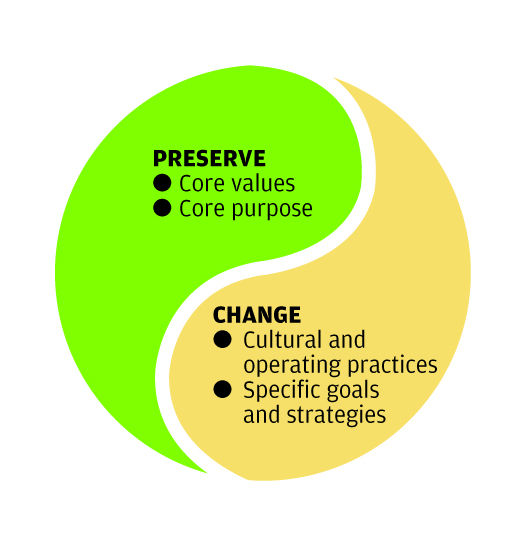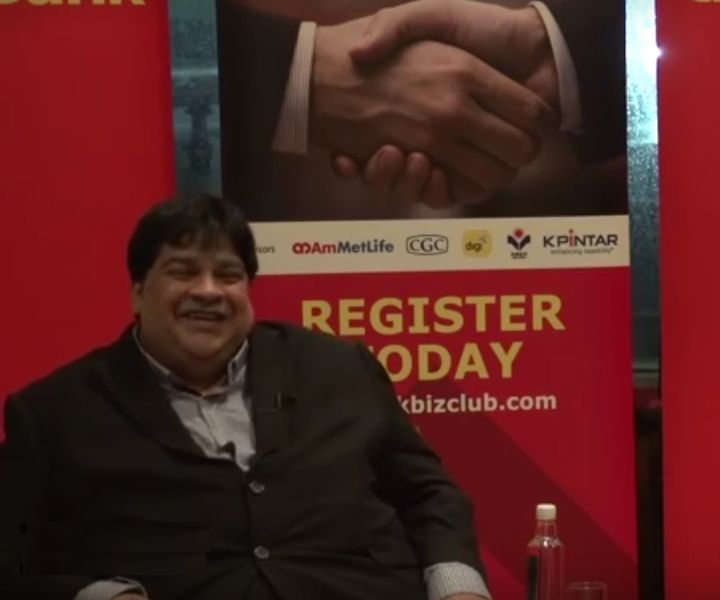The Duality Of Company Vitality

Photo source: mannewaar
Preserving the core while stimulating progress
Earlier this week, I learned a management lesson from an avocado tree. I’m most aware that management teachers do not usually take the form of vegetation responsible for delicious salad ingredients, but the business lesson was quite profound all the same.
It has to do with how to plant an avocado tree from a seed.
Essentially, to grow your own avocado tree, take an avocado pit and with the help of toothpicks, suspend it over a glass filled with water (push toothpicks into the pit, and let them rest on the rim of the glass). Half the pit should be in the water, and the other half exposed to fresh air.
After three to six weeks, roots will begin to grow below the water surface, and a stem will sprout at the top of the pit.
When the stem has grown to 12cm or 15cm, prune it back. When the roots have grown stronger and the stem has regrown, the young tree can then be planted into soil.
Here are two things I note about this avocado tree-growing process:
- It is just as important for the avocado pit to grow a stem, as it is to grow roots. This point is worth rereading. At times we can be overly engrossed with the need to grow strong roots, while at other times, we can be too focused on the need to see visible signs of upward growth. Nature, as we see, seems to take a balanced approach.
- You can prune the stem, but you don’t prune the roots. The base of the young tree is untouched in order to allow it time to strengthen. The stem on the other hand may be pruned for the sake of more luscious future growth.
For those familiar with the principles of Good to Great by Jim Collins, the avocado pit brings to life Collins’ “preserve the core/stimulate progress” duality, a concept which he observes in successful companies like Disney and Walmart that have endured the test of time.
He explains:
Enduring companies preserve their core values and purpose while their business strategies and operating practices endlessly adapt to a changing world. This is the magical combination of ‘preserve the core and stimulate progress’.
While the roots of the avocado pit echo the core values and the purpose of companies, the stem reflects ever-adapting business strategies and operating practices.
Like the avocado tree-growing method illustrates, the former must maintain, while the latter must ready itself to change according to the demands of the company’s future growth.
1. Define, solidify and preserve the core
According to Collins, the “core” that enduring great companies successfully preserve consists of the core values and the core purpose of a company.
In case you’re wondering whether values like “innovation” are present in all successful long-lived companies, Collins interestingly notes that there is no single magic core value common in all enduring companies.
“The point is not what core values you have,” he writes, “but that you have core values at all, that you know what they are, that you build them explicitly into the organisation, and that you preserve them over time.
So from the 1920s to the 1990s, while The Walt Disney Company employed different strategies and expanded from cartoons through to television shows, theme parks and even cruise lines, its core remained.
It held strongly to its values (“passion for creative imagination”, “fanatic attention to detail”, “abhorrence of cynicism”, and “the ‘Disney Magic’”) and anchored itself on its purpose of “bringing happiness to millions”.
Good to Great isn’t alone in this emphasis on the “core”. In 1983, business strategist and author Arie de Geus, who was then coordinator of planning at Shell, set out with a group of researchers to investigate key characteristics of large, long-lived companies.
Anticipating the day when oil reserves would dry up, Shell’s planning team wanted to learn from other large companies that had sustained its success for longer than Shell had. As Shell itself had its beginnings in the 1890s, only 40 companies worldwide made the cut.
After studying 27 of these companies, including organisations like DuPont and Japanese group Mitsui, the team observed “a strong sense of identity” in these long-living companies.
In de Geus’ award-winning book The Living Company published in 1997, he writes:
No matter how widely diversified they were, their employees (and even their suppliers, at times) felt they were all part of one entity […] This sense of belonging to an organisation and being able to identify with its achievements can easily be dismissed as a ‘soft’ or abstract feature of change. But case histories repeatedly showed that strong employee links were essential for survival amid change.
Practical implications for decision-makers seeking to build a company to last for the long run:
- Emphasise the values of the organisation and communicate how they are built into every facet of the company
- Anchor the company on a clear purpose. This feeds the sense of identity, which functions as a secure base and provides the stability necessary for employees to weather and execute change
- Develop a cult-like culture. Linked to the company’s sense of identity, Collins observes that great companies like Disney build specific traditions around the company’s core ideologies.
“Disneyland employees are ‘cast members.’ Customers are ‘guests’. Jobs are ‘parts’ in a ‘performance’,” he writes.
- Set the company up for long-term success by being a “clock builder”, not a “time teller”. Collins explains that leaders with remarkable skill, such as of telling the time, must focus their efforts not on time-telling, but on building clocks. Building and strengthening the company so that it can last beyond the lifetime of particular leaders is the ultimate goal.
2. Embrace change and stimulate progress
The second part of the vitality duality involves strategies and operating practices “endlessly adapting to a changing world”.
While elements of the “core” are steadfast in nature and operate as an anchor and compass for the company, the “avocado stem”, or strategies and practices, must surrender themselves to more dynamic forces and circumstances.
To revisit the example of Disney, the transition from animated cartoons to theme parks was a large leap to make.
However, after visiting several theme parks in the 1950s and concluding that Disney could do a far better job of them, Walt Disney began its theme park business. Today, Disney theme parks are vacation destinations coveted by children all over the world.
De Geus in his book also similarly identifies the ability of long-lasting companies to “learn and adapt”. He explains:
Whether they had built their fortunes on knowledge (such as DuPont’s technological innovations) or on natural resources (such as the Hudson Bay Company’s access to the furs of Canadian forests), they remained in harmony with the world around them. As wars, depressions, technologies, and political changes surged and ebbed around them, they always seemed to excel at keeping their feelers out, tuned to whatever was going on around them.
For Disney, it was cartoons to theme parks. For Shell, it evolved from a family business in 1833 trading seashells to a global group of energy and petrochemical companies.
For the 128-year-old Japanese group Mitsui, it was rice trading to metals, machinery and infrastructure, chemicals, energy, lifestyle, and innovation and corporate development.
But how exactly is this bold evolution to be accomplished? Enter Collins’ BHAGs (big hairy audacious goals), which he proposes as one way to drive constant progress.
According to Collins, “the point is not to find the ‘right’ BHAGs but to create BHAGs so clear, compelling, and imaginative that they fuel progress”. For Walmart’s Sam Walton, his BHAG in 1945 was to “make my little Newport store the best, most profitable in Arkansas within five years.”
Collins also suggests creating environments that encourage learning and experimentation. 3M, for instance, allows its employees to devote 15% of their time to test out new ideas. This “15 Percent Time”, as 3M terms it, can be credited for products such as the Post-It note and 3M Display Film.
“Management that is destructively critical when mistakes are made kills initiative. And it’s essential that we have many people with initiative if we are to continue to grow,” said William McKnight, former president and chairman of the 3M board.
Collins clarifies that this drive for continuous improvement is inherent in the cultural fabric of great companies. The fuel is not to beat out competition, but a desire to constantly “do better tomorrow”.
In today’s circumstances where dynamics change rapidly, the ability of a company to learn and adapt quickly is more crucial than ever.
“The ability to learn faster than your competitors may be the only sustainable competitive advantage,” says de Geus.
I’d venture to say that companies today set on being great must go one step further. Beyond adapting to the present, they must create and engage with the potential future.
It’s an approach that the late Steve Jobs addresses in the closing chapter of his biography by Walter Isaacson, where he explains in his own words what it meant for him to build Apple as an ‘enduring company’:
“The products, not the profits, were the motivation… Some people say, ‘Give the customers what they want.’ But that’s not my approach. Our job is to figure out what they’re going to want before they do. I think Henry Ford once said, ‘If I’d asked customers what they wanted, they would have told me, ‘A faster horse!’ People don’t know what they want until you show it to them. That’s why I never rely on market research. Our task is to read things that are not yet on the page.”
Practical implications for decision-makers seeking to build a company to last for the long run:
- Consider setting BHAGs for the company – compelling goals that will inspire and spur growth and development
- Build an environment and culture where employees are encouraged to and rewarded for initiative and experimentation
- Cultivate, in Jobs’ words, the ability to “read things that are not yet on the page”
Closing remarks
For me, the image of an avocado pit half submerged in water, and the other half exposed to the air, is a powerful reminder of the dual forces companies must balance.
The pit fully under the water surface would be an inward-looking organisation; on the other hand, a pit completely exposed to the air would experience undisciplined and unaligned growth, if it can even grow at all.
Just as the avocado seed positions itself to both strengthen inwardly and grow outwardly in this “vitality duality”, so must companies.
Importantly, as the pruning of the stem represents, we must also embrace the pain or struggle of a shift in our organisations that may be necessary for long-term gain.
Like nature has long been practising, both roots and stem must grow at the same time. Perhaps we should all attempt to grow avocado trees as a reminder.
“I wish that we may attain our greatest ambitions by never sacrificing eternal gain for short-term benefits.” – Takashi Masuda, Mitsui president in the early 1900s
Lily Cheah looks after employee engagement at Leaderonomics, an organisation which she hopes to last for generations by preserving the core and driving progress. To interact with her, drop her a line at lily.cheah@leaderonomics.com . Click HERE to read more articles regarding business.
Business







